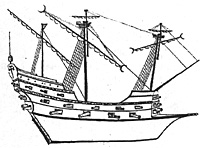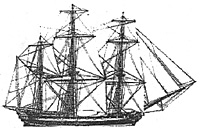 Introduction
Introduction
As the subtitle suggests this is meant to be a fast and furious game. You are the admiral of your fleet and are concerned with manouevring the fleet rather than the performance of individual ships. Having said that, ships are quickly disabled or sunk once the engagement begins and you will need to keep track of what is happening with each ship. I have only mentioned British, French and Spanish nations below. I do recognize that there were other maritime nations at this time. Decide for yourself how well you think those nations should perform and slot them in where you think best. No nation should exceed the British; you may think that your nation should be on a par with the Brits, but they shouldn't be better. (Did I mention that I was a Brit?)
Equipment
A standard pack of playing cards, two or more fleets, a damage record for each ship and a playing area. My table is overlaid with a hexagonal grid so all my "measurements" are in hexes. You could substitute centimetres, inches or feet (!) depending on the scale that you use. Movement would be 2" per mast and you will need a protractor to measure turns.
Movement
2 hexes per mast (turns: 60 degrees per mast)
wind on the quarter +1
wind on the bow -1
Frigates +1
Wind Direction
Check every fifth turn. Black card means that the wind stays the same: Diamond, the wind veers one point (of the compass) clockwise; Heart indicates the wind veering one point anti-clockwise.
Vessel Specification
Ship of the Line 5 hull points/3 mast points
Frigate 3 hull points/3 mast points
 Firing
Firing
Range 4 hexes
Frigates turn over 1 card per broadside
Ships of the Line 3 cards per broadside
Initial broadside +1 card
Bow/stern rake +1 card
Black cards are hull damage, red cards are mast damage.
British crews score damage on any card 5 and above
French crew 7 and above
Spanish crew 9 and above
Aces are low (i.e. Ace to four = no score for the British).
For every hull point damage add one to the hit card (i.e. British ship with two hull points damage now hits the target with any card 7 or higher).
Boarding:
Any ships in adjacent hexes may attempt to board. Turn over a playing card and add the remaining hull points. Highest score wins.
Critical hit:
A pair of red aces means that the targets magazine is hit and the ship explodes.
[Need a good read to get you in the mood for this type of game? Then read Bernard Cornwall’s “Sharpe’s Trafalgar’, for a really vivid description of naval warfare in the days when Britain really did rule the waves. Kenn]
Back to Table of Contents -- Lone Warrior # 146
Back to Lone Warrior List of Issues
Back to MagWeb Magazine List
© Copyright 2004 by Solo Wargamers Association.
This article appears in MagWeb.com (Magazine Web) on the Internet World Wide Web.
Other articles from military history and related magazines are available at http://www.magweb.com
